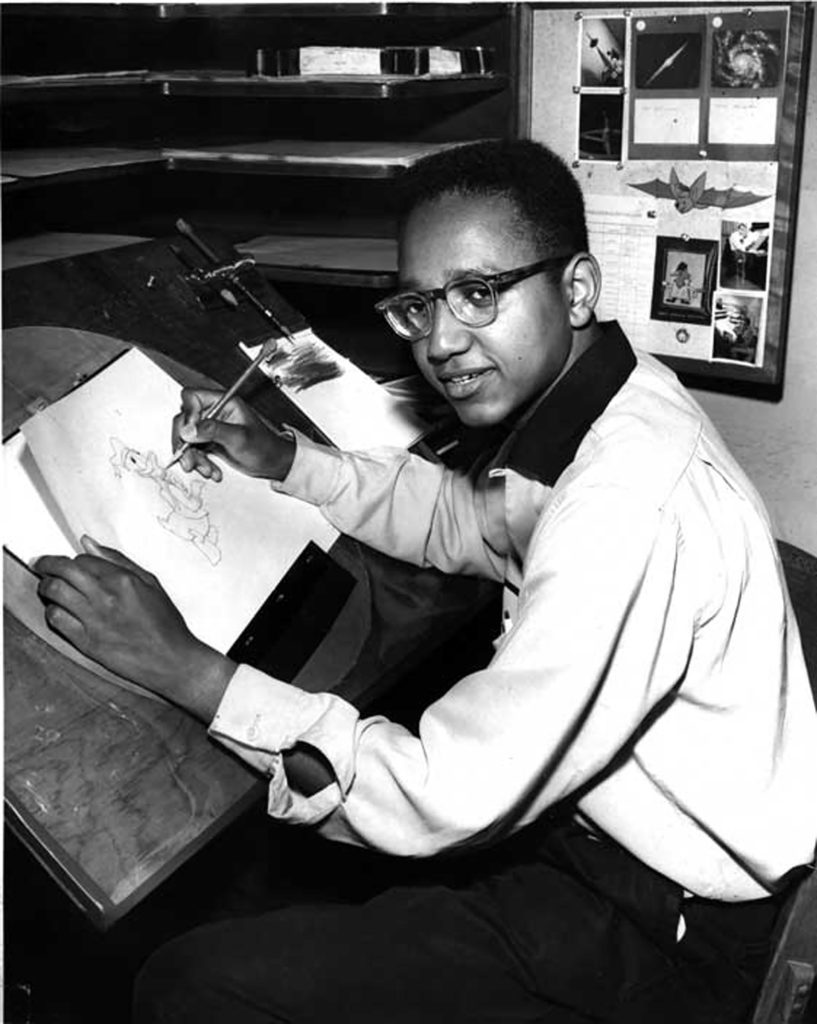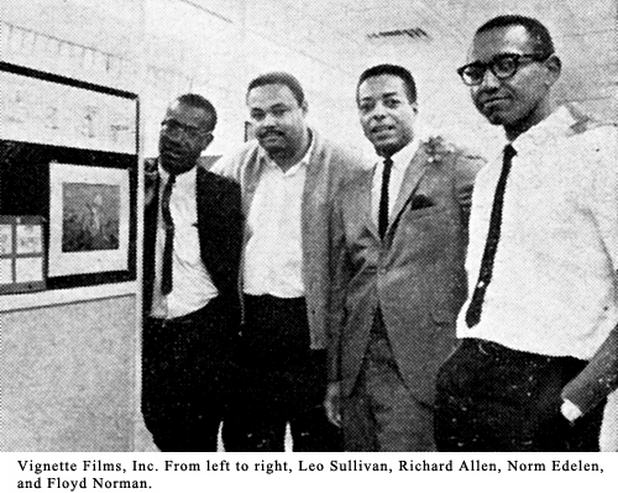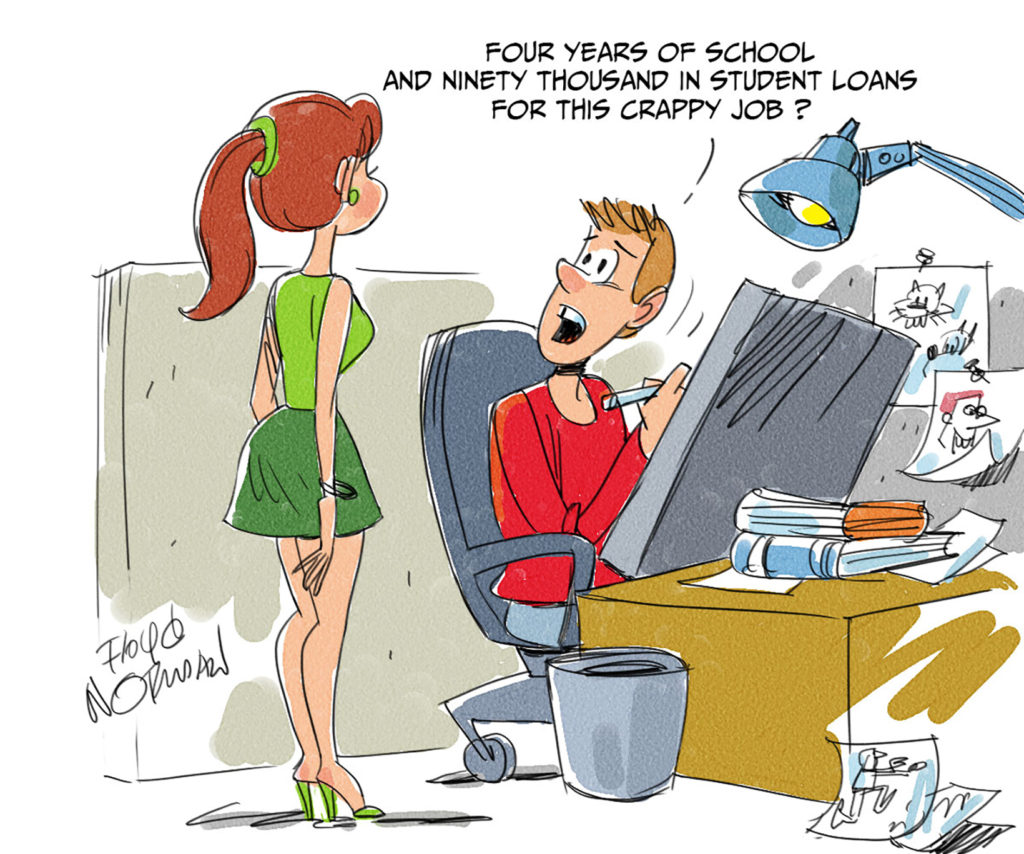July 10, 2017
Artist, Creative Process, Inspiration
Floyd Norman: It’s Not Over Until You Say It’s Over
By Jacqueline Lara (This post originally appeared on 99U)
Animator Floyd Norman’s childhood dream of working at Walt Disney Animation Studios came true in 1956, and, at the age of 81, he’s not done yet.
Norman is the subject of the recent documentary, An Animated Life, which chronicles his life as the first African-American artist to work at Disney, and how he persisted when they forced him into retirement at age 65. “When you get booted out, look at that as the beginning to create something new. My career isn’t over until I say it’s over,” says Norman.
Throughout his colorful career, which began at Disney, Norman has worked for top animation companies including Hanna-Barbera Productions and Pixar. If you’ve seen Sleeping Beauty, The Jungle Book, Mary Poppins, Toy Story 2, or Monsters, Inc., you’ve seen some of Norman’s handiwork. He’s also received numerous industry awards including Comic-Con International’s Inkpot Award and is a Disney Legend, which is the hall of fame program recognizing individuals who have made extraordinary contributions to the Walt Disney Company.
Norman’s career is not without its setbacks. He was drafted to war in 1958, in his twenties, launched his own motion picture production company in Los Angeles, which later closed, and was forced into retirement before he was ready. But, with the resiliency of a child, Norman always bounces back, and encourages creatives to cherish the beginnings—whether it’s the start of a new day, new project, or unexpected opportunity.
Over the years, Norman’s love for the craft and staying current on industry trends have helped him reinvent himself. When he’s not freelancing at Disney or serving as a judge at industry events, he’s speaking at universities to the next generation of animators. “Creative people don’t just hang it up. We want to create magic and continue working,” says Norman.
We spoke with the animator, writer, and comic book artist about his documentary, pivotal moments in his career, and why creatives should care more about beginnings than accomplishments.
Can you briefly tell me about your childhood, and when you developed an interest in the arts?
I grew up in the 1930s in Santa Barbara, CA, and was luckier than most kids. It wasn’t your average community due to its proximity to Hollywood and the entertainment industry. Many residents worked in show business as composers, actors, and writers. So, when we kids expressed an interest in becoming dancers, poets, writers, and musicians, nobody thought this was odd. Seeing Dumbo in the movie theater was a magical experience and inspired me to pursue animation. Many of us left school to become film directors and actors, and in my case, I went to the Walt Disney Studio to make animated films.
Were you parents artists or were they just appreciative of the arts?
Most of my family played at least one musical instrument simply because they enjoyed it. Music was always part of our household. I learned to read music as a child because it would broaden my educational experience. I studied the violin, clarinet, and flute, and played in the high school band and orchestra. This skill came in handy when I began making motion pictures because I could read a music score. You never know how early experiences will help you later in life.
What was it like working at Disney in the 1950s?
It was very exciting because this was my childhood dream—to work for Walt Disney. I still remember receiving the call that I was accepted as an animation intern to come learn the craft.
In An Animated Life, you said, “If you can get through Sleeping Beauty you can do anything.” What made working on this movie so difficult?
For one, this was my first film. Every artist working on a Disney film had to be a darn good artist because the standards were extremely high. Our bosses were demanding, and everything had to be exact. They put us through an animation boot camp to qualify us to work on this feature film.
Back then, films were made entirely by hand. Every image on the screen had to be sketched with a pencil, inked by an inker, and painted by a painter. My primary goal was to learn how to do the job and become better at it. Today, we have technology as a major assist in filmmaking, which means they’re not as dependent on artists.
Can you walk me through the animation boot camp?
It was a cumbersome process. In an animated scene, every drawing must be drawn by hand, and each scene is a series of 10, 50 or even 100 drawings. It’s these individual drawings that give the illusion of life on screen. Consequently, somebody must make all those drawings and there were 600 of us on Sleeping Beauty alone! That’s a lot of artists who must be skilled enough to draw those characters and keep the characters on model. If you don’t love it, you won’t last long in this business. The artists who did this work were die-hards.
How many years did it take to make Sleeping Beauty?
This film was an exception, and took about six years to make. Walt Disney had just gone into television and he was building a theme park in Anaheim, called Disneyland. Many artists struggled to keep his attention, which slowed down the production process.
After completing Sleeping Beauty, you were drafted into the military in 1958. Did art help you cope during this time?
Yes. As an artist, anytime we’re not at work or doing our job, we start drawing and painting. I’ve always loved motion pictures and storytelling, and as a kid, I watched everything from westerns to war movies. When I found myself in the military, in an odd way, it felt like I was in a Hollywood war movie with John Wayne or Gregory Peck. I think this delusion helped me cope through difficult, stressful situations because I never looked at my situation as being real, even though it was real. I was lucky to return from South Korea without any trauma.
So, after a few years absence from Disney, I was back at my drawing board working on 101 Dalmatians, which was nearly complete.
The animation process wasn’t computerized when you began. Do you feel that technology has distracted from or enhanced the animation industry?
That depends on one’s point of view. It’s a totally different business today because of digital technology, and apps like Photoshop, InDesign, and Illustrator are key. Back then, Walt Disney dominated the animation industry. Occasionally, another studio would try to make a film, but more than likely failed. In recent years, the computer has allowed other players to enter the game, and if they have enough investment to build the digital infrastructure, they can join in. In the 1950s, Disney had an army of skilled artists who took decades to train. Today, a new studio can be up and running in months.
Working in the animation industry demands that you’re funny on cue. Is this difficult?
You’ve got to be a funny person or else you’re not going to be in the business long. If somebody says, “I’ve been called in on a film where one of my bosses said ‘This sequence isn’t making me laugh.’” Well, you fix it and make the sequence funny—that’s your job.
That seems like a lot of pressure. How did you manage?
When your boss is Walt Disney—that’s the guy you must please. And, making the old man laugh is what got me through The Jungle Book. When I joined the project in 1966, The Jungle Book had been in the works for a year, and was a dark, mysterious story. Walt hated it and found it depressing. He said, “I want this picture rewritten. I want it to be fun. And, I want audiences to come out of this movie with a smile on their face.” Lucky for me, I knew exactly what he meant. He wanted to see Disney entertainment on screen. As a kid who grew up on Walt Disney films, read Disney storybooks, Disney comics, and listened to Disney music, I knew what a Disney film was.
So, my colleague Vance Gerry and I analyzed the storyline to bring laughs, music, and humor back into the story, and delivered exactly what Walt wanted. Fifty years later, The Jungle Book, is still very popular with audiences.
What are some tips artists can use to deliver strong storyboard pitches?
I tell young board artists to be confident in what they’ve done. If you’re hesitant about your work, this will show in your pitch. If you feel like you’ve delivered the goods, then you can pitch with confidence because you know what you’re showing works. I’ve always tried to pitch sequences I’ve boarded like, “Look, this is what I’ve done. This is what I feel works, and you can take it or leave it.”
What motivated you to leave Disney to start your own firm?
Walt passed away in December of 1966, which hit me hard. And, my friend Leo Sullivan and I had been talking to educators, and realized nothing existed in school systems addressing black history. We saw a need to create films about black history and culture and knew we could fill this gap as storytellers and filmmakers. So, by the first of the year in 1967, Vignette Films was up and running.
We produced four initial films about Paul Laurence Dunbar who was a poet, Booker T. Washington, an educator, George Washington Carver, a black scientist who played a major role in agriculture in the south, and jazz composer, W.C. Handy, the father of the blues. These were distributed to school systems as educational films, and we’re very proud of the work we’ve done.
You ran into challenges with Vignette Films and had to get creative to keep the business going. What did you do?
We lost our office, and in Hollywood, perception is everything. If you can be perceived as successful, that’s mainly all you need to do. People will fill in the blanks. So, when we moved into a coffee shop, this became our Hollywood office. The payphone became our Hollywood phone number. It was all bogus, but it worked for us. That’s how we managed to keep going, even during difficult times. You must find a way to do things when it looks impossible. We had to finish a motion picture, and had nowhere to do it. What better place to make a movie than in a Hollywood coffee shop? We worked on other projects including the original, iconic Soul Train animation, but eventually closed shop when it became too difficult to make ends meet.
After working for various animation companies, you returned to Disney, only to be forced into retirement when you turned 65. What was it like to be taken away from what you loved most?
It’s tough because when you lose your job, you also lose part of yourself. My identity was so wrapped up in this business—it was part of me. For some time, I walked the streets of my hometown of Pasadena grumbling and feeling rejected. Then, I realized I can’t continue like this and must make a new start. So, I worked at other studios, wrote for television, and did anything I could to stay busy.
I had been pushed out of the game, and was determined to come back on my own terms. Part of this involved coming back to Disney and moving into an office where I didn’t belong. In truth, they could have called security and kicked me off studio property, but they didn’t, so I stuck around year after year. Animator Avi Tuchman affectionately coined what I was doing as “Floydering,” and its stuck ever since.
This ties into your blog post about beginnings—can you talk more about this?
Many people lost their jobs when we went through the transition in animation where hand-drawn animators were replaced by digital technology. People who had been in this business for 20-40 years found themselves without a job. One person who is in his 60s spoke with me about how he’s struggling to find work. I told him this: “You can’t wallow in your misery. You can’t let the corporation run your life. If the corporation boots you out, then find something else to do. If they don’t want you, then find somebody who does. If your job no longer fits in this industry, then create a new job.” Mainly, I’m telling people don’t quit, and don’t let the company—whether it’s Sony, Warner, Disney or DreamWorks—don’t let them run your life. If they kick you out, and one day they will, because they always do, don’t take that as the end.
You’re in charge of your life, not the corporation. That’s why I said, “Screw the corporation.” Always remember—it’s not over until you say it’s over.






 Follow
Follow